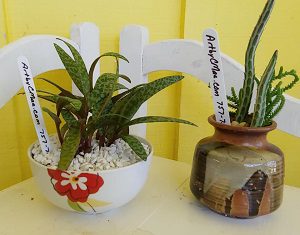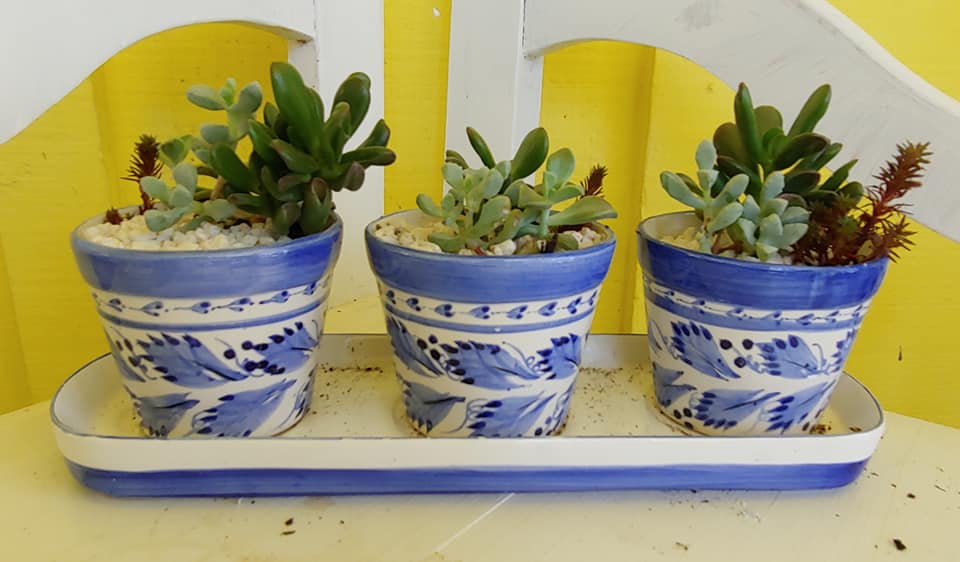If you’re a collector of succulents – or you’re thinking about adding some of these beautiful plants to your home – it’s important to take the time to learn how to keep them happy and healthy all year long.
In this week’s edition of Tips from the Pros, local resident Chris MacCormack, owner of ArtbyCMac, provides her expert tips for caring for your succulents throughout the winter months.
How to Care for Your Succulents in Winter

Most succulents are native to climates that are much different than ours. Since they’re generally used to hot, dry climates, they’ve evolved to store water in their leaves, stems, or roots, which helps get them through periods of drought.
In Florida, we tend to have a lot of rain in the summer months and temperatures that can easily range from 95°F in the summer to the occasional low of 30° F in the dead of winter. This means you’ll need to make some special accommodations to make sure your plants not only survive but thrive in our climate.
Learn About Your Succulents’ Unique Needs
It’s important not to assume that all succulents are the same. They come from many different environments and each species has unique needs. For example, did you know that all cacti are succulents, but not all succulents are cacti?
Some succulents, like sempervium (hen and chicks) are used to cold, dry climates. This makes it harder to keep them healthy in Florida, where it’s hot, humid, and rainy.
The ideal lighting conditions also vary. Most succulents will grow just fine in a well-lit carport, lanai, porch, or windowsill where they will get bright, indirect light most of the day. However, some plants, like the ghost plant, kalanchoe, and echeveria, need more light. Otherwise, they’ll start to reach for the sun, giving them an appearance that collectors refer to as “leggy.” Putting them in full sunlight can cause them to get sunburned at first, but once they get used to it, they’ll grow fuller, stronger, and bigger than they would in lower light conditions.
If you’re not sure what type of care your succulent needs, it’s a great idea to do some research or ask a succulent collector or specialist for advice.
Choose the Right Soil
When it comes to keeping succulents healthy, the soil is critical. Using a well-draining, porous soil will help prevent root and leaf rot. This is true whether you’re planting your succulents in pots or in an outdoor garden. As long as you use the right soil, even heavy rains won’t kill your plants because excess water will quickly drain away. An easy mixture that works well for most succulents is 3 parts Palm/Cactus soil and 1 part perlite.
Protect Your Plants in Winter

During the summer, you can protect outdoor potted plants by watering them about once a week when it hasn’t rained and using a shade cloth until October.
Once winter hits, you’ll have a new set of concerns to deal with. Most succulents can tolerate temperatures down to 35° F for an evening or two, but freezing temperatures can kill many very quickly. When a cold snap is coming and temperatures will be around 40° F or lower, you’ll want to bring your plants indoors or take steps to protect them.
You can do this by gently wrapping the plants in a tablecloth or sheets. A tarp will work in a pinch, but it’s important not to let the plastic touch the plants. Cloth is also a better insulator.
Most indoor succulents, with the exception of cacti and hens and chicks, can be watered about once a week when kept indoors. However, in the winter months, you’ll want to cut this back to about once every 10 days.
Monitor Your Plants’ Health
Many people are nervous about their ability to properly care for succulents. However, almost all succulents are tough, forgiving, and communicative. Keep an eye on them, and it’s easy to figure out what they need.
If the leaves are shriveling, they need water. If the stems are long and “leggy,” they need more light. If leaves are turning brown and soggy, your plant is experiencing root rot from overwatering. When this happens, you need to get the roots out of the wet soil ASAP and allow them to dry off before replanting them in dry soil.
When succulents change color, they’re typically responding to lighting conditions and temperature changes. This is a natural process for them. Enjoy the reds and purples winter weather causes and the richer colors that summer sunlight produces!
If part of your succulent ever dies, don’t panic. Simply cut off the dead portion and replant the remaining healthy part. When you buy succulents, make note of the conditions that they were used to and make changes gradually. Check that the pot has drain holes and that the soil is light and loose.
Succulents can be repotted, divided, trimmed, and beheaded and they will grow back. Just be patient. They are not in a hurry, but they are experts at survival.





One thought on “How to Care for Succulents in Winter – ArtbyCMac”
Great idea for you to have listed succulent plant information! They have become very popular so this is very timely and needed. (I have a granddaughter that has over 50 of them!!)
Comments are closed.